House of Ascania
The House of Ascania (German: Askanier) was a dynasty of German rulers. It is also known as the House of Anhalt, which refers to its longest-held possession, Anhalt.[1]
| House of Ascania | |
|---|---|
.svg.png.webp)  .svg.png.webp) | |
| Country | |
| Founded | 1036 |
| Founder | Esiko, Count of Ballenstedt |
| Current head | Eduard, Prince of Anhalt |
| Final ruler | Joachim Ernst, Duke of Anhalt |
| Titles | |
| Deposition | 1918 (Duchy of Anhalt) |
The Ascanians are named after Ascania (or Ascaria) Castle, known as Schloss Askanien in German, which was located near and named after Aschersleben.[2][3] The castle was the seat of the County of Ascania, a title that was later subsumed into the titles of the princes of Anhalt.
History
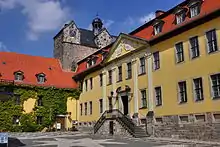 Ballenstedt Castle
Ballenstedt Castle.svg.png.webp) First coat of arms of the family
First coat of arms of the family.svg.png.webp) Map of Anhalt (1747–1793)
Map of Anhalt (1747–1793)
The earliest known member of the house, Esiko, Count of Ballenstedt, first appears in a document of 1036. He is assumed to have been a grandson (through his mother) of Odo I, Margrave of the Saxon Ostmark. From Odo, the Ascanians inherited large properties in the Saxon Eastern March.
Esiko's grandson was Otto, Count of Ballenstedt, who died in 1123. By Otto's marriage to Eilika, daughter of Magnus, Duke of Saxony, the Ascanians became heirs to half of the property of the House of Billung, former dukes of Saxony.
Otto's son, Albert the Bear, became, with the help of his mother's inheritance, the first Ascanian duke of Saxony in 1139. However, he soon lost control of Saxony to the rival House of Guelph.
Albert inherited the Margraviate of Brandenburg in 1157 from its last Wendish ruler, Pribislav, and he became the first Ascanian margrave. Albert, and his descendants of the House of Ascania, then made considerable progress in Christianizing and Germanizing the lands. As a borderland between German and Slavic cultures, the country was known as a march.
In 1237 and 1244, two towns, Cölln and Berlin, were founded during the rule of Otto and Johann, grandsons of Margrave Albert the Bear. Later, they were united into one city, Berlin. The emblem of the House of Ascania, a red eagle and bear, became the heraldic emblems of Berlin. In 1320, the Brandenburg Ascanian line came to an end.
After the Emperor had deposed the Guelph rulers of Saxony in 1180, Ascanians returned to rule the Duchy of Saxony, which had been reduced to its eastern half by the Emperor. However, even in eastern Saxony, the Ascanians could establish control only in limited areas, mostly near the River Elbe.
In the 13th century, the Principality of Anhalt was split off from the Duchy of Saxony. Later, the remaining state was split into Saxe-Lauenburg and Saxe-Wittenberg. The Ascanian dynasties in the two Saxon states became extinct in 1689 and in 1422, respectively, but Ascanians continued to rule in the smaller state of Anhalt and its various subdivisions until the monarchy was abolished in 1918.
Catherine the Great, Empress of Russia from 1762 to 1796, was a member of the House of Ascania, herself the daughter of Christian August, Prince of Anhalt-Zerbst.
Rulers of the House of Ascania
Partitions of the House of Ascania
| County of Weimar-Orlamunde (1113–1247) |
County of Ballenstedt (1030–1170) | |||||||||||||||||||||
| Duchy of Saxony (1180–1296) |
Margraviate of Brandenburg (1157-1266/67) |
County of Anhalt (1123–1212) Raised to: Principality of Anhalt (1212–1252) | ||||||||||||||||||||
| Weimar (1247–1372) |
Orlamunde (from 1354 in Schauenforst) (1247–1420) |
Zerbst (1st creation) (1252–1396) |
Bernburg (1st creation) (1252–1468) |
Aschersleben (1252–1315) | ||||||||||||||||||
| Stendal (1266–1318) Split in:
|
Salzwedel (1267–1317) |
Stargard (1267–1316) | ||||||||||||||||||||
| Plassenburg (1285–1340) |
Lauenstein (1285–1460) |
Wittenberg (1296–1356) Raised to: Electorate of Saxe-Wittenberg (1356–1422) |
Lauenburg (1296–1303) | |||||||||||||||||||
| Mölln (1303–1401) |
Ratzeburg (1303–15) |
Margraviate of Brandenburg (Neumark then Stendal lines) (1318–20) |
Annexed to the Duchy of Mecklenburg | |||||||||||||||||||
| Bergdorf (1303–15) Renamed as Ratzeburg (1315–1401) |
Annexed to the House of Wittelsbach |
Annexed to Bishopric of Halberstadt | ||||||||||||||||||||
| Annexed to the House of Wettin | ||||||||||||||||||||||
| Lauenburg (Ratzeburg line) (1401–1689) |
Köthen (1st creation) (1396–1562) |
|||||||||||||||||||||
| Annexed to the House of Wettin |
Dessau (1st creation) (1396–1561) | |||||||||||||||||||||
| Zerbst (2nd creation) (1544–62) |
Plotzkau (1st creation) (1544–53) | |||||||||||||||||||||
| Principality of Anhalt (Zerbst line) (1562–1603) | ||||||||||||||||||||||
| Köthen (2nd creation) (1603–1847) |
Plotzkau (2nd creation) (1603–65) |
Dessau (2nd creation) (1603–1863) |
Zerbst (3rd creation) (1603–1793) |
Bernburg (2nd creation) (1603–1863) | ||||||||||||||||||
| Annexed to the House of Welf |
||||||||||||||||||||||
| Duchy of Anhalt (Dessau line) (1863–1918) | ||||||||||||||||||||||
Table of rulers
| Ruler | Born | Reign | Death | Ruling part | Consort | Notes | |
|---|---|---|---|---|---|---|---|
| Adalbert I | c.970 | c.1000–1036 | 1036 | County of Ballenstedt | Hidda four children | Founder of the family. | |
| Esico | c.1000 | 1036–1060 | 1060 | County of Ballenstedt | Matilda of Swabia 1026 three children | ||
| Adalbert II | 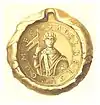 | c.1030 | 1060–1080 | c.1080 | County of Ballenstedt | Adelaide of Weimar-Orlamünde c.1070 two children | |
| Otto I the Rich | c.1070 | 1080–1123 | 9 February 1123 | County of Ballenstedt | Eilika of Saxony c.1095 two children |
Children of Adalbert II, divided their rule. | |
| Siegfried I | c.1075 | 1080–1113 | 9 March 1113 | County of Weimar-Orlamünde | Gertrude of Northeim 1026 three children | ||
| Regencies of Gertrude of Northeim (1113–1115) and Otto I, Count of Salm (1115–1121) | Left no descendants. The county went to his brother. | ||||||
| Siegfried II | 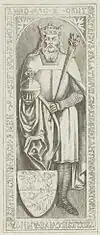 | 1107 | 1113–1124 | 19 March 1124 | County of Weimar-Orlamünde | Irmgard of Henneberg no children | |
| Albert I the Bear | 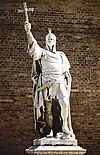 |
c.1100 | 1123–1170 | 18 November 1170 | County of Ballenstedt | Sophie of Winzenburg 1124 thirteen children |
Besides count of Ballenstedt, he was also the first Margrave of Brandenburg (1157). Ruler of the Northern March from 1134, and the county of Weimar-Orlamünde since 1140. |
| 1157–1170 | Margraviate of Brandenburg | ||||||
| William | 1112 | 1124–1140 | 13 February 1140 | County of Weimar-Orlamünde | Adelaide no children | Left no descendants. The county went to his cousin, Albert the Bear, from Ballenstedt. | |
| Bernard I | 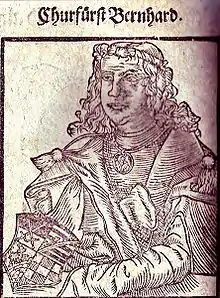 | c.1134 | 1170–1212 | 2 February 1212 | Anhalt | Brigitte of Denmark six children Sophia of Thuringia one child Judith of Poland c.1173 no children |
Children of Albert the Bear, divided their rule. Bernard was also Count of Ballenstedt and Duke of Saxony |
| Otto I |  | 1128 | 1170–1184 | 8 July 1184 | Margraviate of Brandenburg | Judith of Poland 1148 two children Ada of Holland 1175 one child | |
| Herman I | 1130 | 1170–1176 | 19 October 1176 | County of Weimar-Orlamünde | Irmgard two children | ||
| Siegfried III | 1155 | 1176–1206 | 1206 | County of Weimar-Orlamünde | Sophia of Denmark (1159–1208) c.1180 three children | ||
| Otto II the Generous | _Siegesallee_Zitadelle.JPG.webp) | c.1150 | 1184–1205 | 4 July 1205 | Margraviate of Brandenburg | Unmarried | Left no descendants, and the Margraviate went to his brother. |
| Albert II | 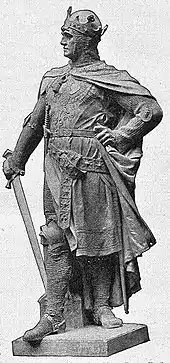 | 1177 | 1205–1220 | 25 February 1220 | Margraviate of Brandenburg | Matilda of Lusatia (1185–1225) 1205 four children | Brother of the previous. |
| Albert II | 1182 | 1206–1245 | 22 October 1245 | County of Weimar-Orlamünde | Unmarried | Children of Siegfried III, ruled jointly. | |
| Herman II | %252C_Brakteat%252C_mcsearch_(2).JPG.webp) | 1184 | 1206–1247 | 27 December 1247 | County of Weimar-Orlamünde | Beatrix of Andechs-Merania c.1230 six children | |
| Otto II | c.1185 | 1206–1211 | 1211 | County of Weimar-Orlamünde | Unmarried | ||
| Henry I | .jpg.webp) | 1170 | 1212–1252 | 1252 | Anhalt | Irmgard of Thuringia 1211 eleven children |
Children of Bernard, divided their rule. In 1218 Henry becomes Prince of Anhalt, which after his death is divided by his sons. |
| Albert I |  | c.1175 | 1212–1260 | 7 October 1260 | Saxony | Agnes of Austria 1222 five children Agnes of Thuringia 1238 three children Helene of Brunswick-Lüneburg 1247 five children | |
| Regencies of Henry I, Count of Anhalt (1220–25), Albert I, Archbishop of Magdeburg (1220–21), Matilda of Lusatia (1221–25) | Children of Albert II, ruled jointly, but their children divided the margraviate. | ||||||
| John I |  | 1213 | 1220–1266 | 4 April 1266 | Margraviate of Brandenburg | Sophie of Denmark (1217–1247) 1230 six children Brigitte Jutta of Saxony (d. 4 April 1266) 1230 six children | |
| Otto III the Pious | 1215 | 1220–1267 | 9 October 1267 | Margraviate of Brandenburg | Beatrice of Bohemia 1243 six children | ||
| Otto III the Magnificent |  | 1236 | 1247–1285 | 13 May 1285 | County of Weimar | Agnes of Leiningen (c. 1230/40-13 May 1285) 1266 four children |
Children of Herman II, Herman III and Otto III, divided the county:
|
| Albert III | c.1240 | 1247–1283 | 1283 | County of Weimar | Unmarried | ||
| Herman III the Popular | c.1240 | 1247–1283 | 1283 | County of Orlamünde | Beatrix of Andechs-Merania c.1230 six children | ||
| Sophia | c.1190? | 1247–1270 | 1270 | County of Weimar-Orlamünde (at Regnitzland) | Henry VIII, Lord of Weida 19 July 1258 three children | ||
| Henry II the Fat | .jpg.webp) | 1215 | 1252–1266 | 12 June 1266 | Anhalt-Aschersleben | Matilda of Brunswick-Lüneburg 1245 two children |
Children of Henry I, divided their rule. |
| Bernard I | .jpg.webp) | 1218 | 1252–1287 | 1287 | Anhalt-Bernburg | Sophia of Denmark 3 February 1258 Hamburg six children | |
| Siegfried I | 1230 | 1252–1298 | 25 March 1298 | Anhalt-Zerbst | Catherine of Sweden 17 October 1259 ten children | ||
| Albert II | 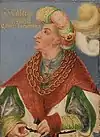 |
1250 | 1260–1296 | 25 August 1298 | Saxony | Agnes of Austria 1282 six children |
Ruled jointly; and associated his nephews to the joint rulership after his brothers death. However, these three nephews divided the land with him. Albert II retained Saxe-Wittenberg, and became the head of the Elder Saxon Line; Albert III, Eric I and John II ruled together in Saxe-Lauenburg, becoming the founders of the Younger Saxon Line. |
| 1296–1298 | Saxe-Wittenberg | ||||||
| John I | 1249 | 1260–1282 | 30 July 1285 | Saxony | Ingeborg Birgersdotter of Sweden 1270 eight children | ||
| In 1296 Albert II and his nephews Albert III, Eric I, and John II ended their joint rule and divided Saxony into the Lauenburg line, where Albert III, Eric I, and John II continued to rule jointly until 1303, and the Wittenberg line, where Albert II continued as sole ruler until 1298. Since the Duke of Saxony was considered one of the prince-electors electing a new Holy Roman Emperor, conflict arose between the lines of Lauenburg and Wittenberg over the issue of who should cast Saxony's vote. In 1314 both lines found themselves on different sides in a double election. Eventually, the Dukes of Saxe-Wittenberg succeeded in 1356 after the promulgation of the Golden Bull. To distinguish him from other rulers bearing the title Duke of Saxony, he was commonly called Elector of Saxony. | |||||||
| Regency of Matilda of Brunswick-Lüneburg (1266–1270) | Children of Henry II, ruled jointly, first under their mother, who was elected Abbess of Gernrode in 1275. In 1283, Henry renounced his rights in Otto's favor. | ||||||
| Otto I | .jpg.webp) | c.1245 | 1266–1304 | 25 June 1304 | Anhalt-Aschersleben | Hedwig of Wrocław 1283 three children | |
| Henry III | c.1245 | 1266–1283 | 12 June 1266 | Anhalt-Aschersleben | Unmarried | ||
| John II | _Johann_II.JPG.webp) | 1237 | 1267–1281 | 10 September 1281 | Margraviate of Brandenburg (at Krossen) | Hedwig of Werle (1243–1287) c.1260 two children |
Children of John I. Despite co-rulership between them, they received different parts in the Margraviate to rule (alone or in co-rulership):
|
| Otto IV of the Arrow |  | 1238 | 1267–1308 | 27 November 1308 | Margraviate of Brandenburg (at Stendal) | Heilwig of Holstein-Kiel (d.1305) 1279 no children Judith of Henneberg (d.1315) 1308 no children | |
| Conrad I | 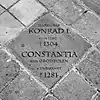 | 1240 | 1267–1304 | 1304 | Margraviate of Brandenburg (at Neumark) | Constance of Greater Poland 1260 Santok three children | |
| Otto VII |  | c.1260 | 1286–1297 | 1297 | Margraviate of Brandenburg (at Neumark) | Unmarried | |
| John III of Prague | 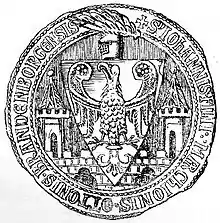 | 1213 | 1267–1268 | 4 April 1266 | Margraviate of Brandenburg (at Salzwedel) | Unmarried | Children of Otto III. Despite co-rulership between them, they received different parts in the Margraviate to rule (alone or in co-rulership):
|
| Otto V the Tall | 1246 | 1267–1298 | 1298 | Margraviate of Brandenburg (at Salzwedel) | Judith of Henneberg-Coburg (1252–1327) 22 October 1268 four children | ||
| Otto VI the Short | 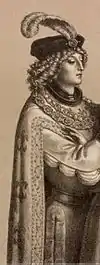 | 3/17 November 1264 | 1267–1286 | 6 July 1303 | Margraviate of Brandenburg (at Salzwedel) | Hedwig of Habsburg February 1279 Vienna no children | |
| Albert III | .jpg.webp) | c.1250 | 1267–1300 | Between 19 Sept. and 4 Dec. 1300 | Margraviate of Brandenburg (at Stargard) | Matilda of Denmark(d.1300) 1268 four children | |
| Conrad II | 1261 | 1281–1308 | 1308 | Margraviate of Brandenburg (at Krossen) | Unmarried | With his childless death his land reverted to Stendal. | |
| Henry I | c. 1270 | 1283–1354 | 26 March 1354 | County of Orlamünde | Irmgard of Schwarzburg-Blankenburg (d.26 March 1354) 26 July 1313 two children |
Children of Herman III, ruled jointly. | |
| Herman V[4] | c. 1270 | 1283–1312 | 1312 | County of Orlamünde | Unmarried | ||
| Elisabeth (I) the Elder | 1265 | 1283–1333 | 1333 | County of Orlamünde (at Nordhalben) | Hartmann XI, Count of Lobdeburg-Arnshaugk one child Albert II, Margrave of Meissen 1 October 1290 no children | ||
| Herman IV[4] | 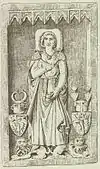 | c. 1270 | 1285–1319 | 13 May 1285 | County of Weimar (at Weimar) | Matilda of Rabenswalde (d.1339) 24 November 1290 four children |
Children of Otto III, divided their rule. |
| Otto IV the Younger | 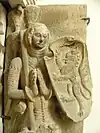 | 1279 | 1285–1318 | 13 May 1285 | County of Weimar (at Plassenburg) | Adelaide of Kafernburg (d.c.1305) 14 December 1296 one child Catherine of Hesse (1286–1322) 1308 one child | |
| Bernard II | .jpg.webp) | 1260 | 1287–1323 | After 26 December 1323 | Anhalt-Bernburg | Helena of Rügen 27 December 1302 three children |
Ruled jointly. After the death of John, Bernard ruled alone. |
| John I | 1258/60 | 1287–1291 | 5 June 1291 | Anhalt-Bernburg | Unmarried | ||
| John II | 1275 | 1296–1303 | 22 April 1322 | Saxe-Lauenburg | Elizabeth of Holstein-Rendsburg 1315 one child |
Children of John I, co-ruled first with their uncle Albert II since 1282 (since the death of their father), and in 1296 split the land with him. They retained Lauenburg, which they divided once more. Albert passed the land to his widow, and after her death, in 1315, the territory was realigned: Eric divided Bergdorf with his surviving brother and held all of his brother Albert's inheritance. However, he ended up abdicating to his son, and survived for most of his reign. | |
| 1303–1322 | Saxe-Mölln | ||||||
| Eric I | 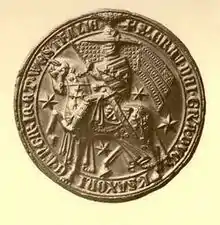 |
1280 | 1296–1303 | 1360 | Saxe-Lauenburg | Elisabeth of Pomerania 1316 or 1318 four children | |
| 1303–1338 | Saxe-Bergedorf (1303–15) Saxe-Ratzeburg (1315–38) | ||||||
| Albert III | 1281 | 1296–1303 | 1308 | Saxe-Lauenburg | Margaret of Brandenburg-Salzwedel 1302 two children | ||
| 1303–1308 | Saxe-Ratzeburg | ||||||
| Margaret of Brandenburg-Salzwedel | 1270 | 1308–1315 | 1 May 1315 | Saxe-Ratzeburg | Przemysł II, King of Poland 1302 two children Albert III 1302 two children | ||
| In 1315, after the death of Margaret of Brandenburg, the remaining brothers Eric and John redesigned the political division in Saxe-Lauenburg; Eric retained all of Margaret's part, but had to give part of his original domains to his brother. | |||||||
| Rudolph I (Rudolf I) | 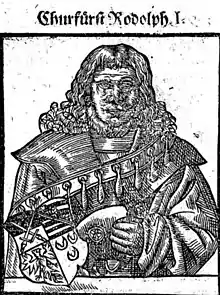 | 1284 | 1298–1356 10 January 1356 – 12 March 1356 | 12 March 1356 | Saxe-Wittenberg Electorate of Saxony | Jutta of Brandenburg 1298 eight children Kunigunde of Poland 28 August 1328 one child Agnes of Lindow-Ruppin 1333 three children | In January 1356 the Golden Bull confirmed Rudolf I as the legitimate Saxon Prince-Elector, thus the rulers of Saxe-Wittenberg are conceived as Electors of Saxony. |
| The Golden Bull of 1356 confirmed the right to participate in the election of a Holy Roman Emperor to the Duke of Saxony in the Saxe-Wittenberg line. | |||||||
| Albert I | c.1260 | 1298–1316 | 17 August 1316 | Anhalt-Zerbst | Liutgard of Holstein-Itzehoe after 1277 two children Agnes of Brandenburg-Stendal 1300 five children | ||
| Herman the Tall | 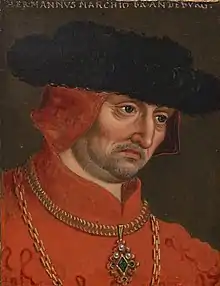 | 1275 | 1298–1308 | 1 February 1308 | Margraviate of Brandenburg (at Salzwedel) | Anne of Austria 1295 Graz four children |
Children of Otto V, divided the land. Beatrice's part was then annexed to the Duchy of Świdnica-Jawor. |
| Beatrice (I) | 1270 | 1298–1316 | 1316 | Margraviate of Brandenburg (at Upper Lusatia) | Bolko I, Duke of Świdnica 4 October 1284 Berlin ten children Władysław, Duke of Bytom 21 September 1308 two children | ||
| Beatrice (II) | c. 1270 | 1300–1314 | 22 September 1314 | Margraviate of Brandenburg (at Stargard) | Henry II, Lord of Mecklenburg 1292 Stargard Castle four children | Daughter and heiress of Albert III. Her marriage transferred the Stargard region into the Duchy of Mecklenburg. | |
| John IV |  | 1261 | 1304–1305 | 1305 | Margraviate of Brandenburg (at Neumark) | Unmarried | Co-ruler of his father since 1291. His childless death reverted his lands to Stendal. |
| Otto II | _-_drittes_Reitersiegel_und_Otto_II_(Anhalt)_-_Reitersiegel.jpg.webp) | c.1260 | 1304–1315 | 24 July 1315 | Anhalt-Aschersleben | Elisabeth of Meissen 24 August 1309 two children | After his death in 1315 without male heirs, the Principality was annexed by the Bishopric of Halberstadt. |
| Definitively annexed by the Bishopric of Halberstadt | |||||||
| Henry I Lackland | 21 March 1256 | 1308–1318 | 14 February 1318 | Margraviate of Brandenburg (at Delitzsch since 1297; at Stendal since 1308) | Agnes of Bavaria 1303 three children | Younger brother of John II, Otto IV and Conrad I. Started his co-rulership in 1297, receiving seat at Delitzsch; he ended up as successor of his childless elder brother Otto IV. | |
| Regency of Waldemar, Margrave of Brandenburg-Stendal (1308–1316) | Children of Herman, divided the land:
John's childless death left the main core of Salzwedel to be reunited by his regent Valdemar. The remaining possessions were annexed by the respective marriages. | ||||||
| John V the Illustrious | 1302 | 1308–1317 | 26 March 1317 | Margraviate of Brandenburg (at Salzwedel) | Unmarried | ||
| Matilda | 1296 | 1308–1329 | 31 March 1329 | Margraviate of Brandenburg (at Lower Lusatia) | Henry IV, Duke of Żagań 5 January 1310 four children | ||
| Agnes | .JPG.webp) | 1297 | 1308–1334 | 27 November 1334 | Margraviate of Brandenburg (at Altmark) | Waldemar, Margrave of Brandenburg-Stendal 1309 no children Otto, Duke of Brunswick-Lüneburg 1319 no children | |
| Judith |  | 1301 | 1308–1353 | 1353 | Margraviate of Brandenburg (at Coburg) | Henry IX, Count of Henneberg-Schleusingen 1 January 1317 or 1 February 1319 five children | |
| Albert II | after 1277 | 1316–1362 | 17 July 1362 | Anhalt-Zerbst | Agnes of Rügen 2 September 1324 no children Beatrix of Saxe-Wittenberg c.1337 five children |
Albert III and Valdemar I ruled jointly, as sons of Albert II. In 1359 Albert III associated his eldest son, Albert IV, but he predeceased him. In 1362, after Albert III's death, is brother Valdemar continued the co-ruling with his nephew John II. Valdemar II, Valdemar I's son, joined John II after his father's death. | |
| Valdemar I | after 1277 | 1316–1368 | 7 January 1368 | Anhalt-Zerbst | Elisabeth of Saxe-Wittenberg 22 June 1344 six children Beatrice d'Este 1365 no children | ||
| Albert III | c.1337 | 1359 | 1 August 1359 | Anhalt-Zerbst | Unmarried | ||
| John II | after 1337 | 1362–1382 | 11 April 1382 | Anhalt-Zerbst | Elisabeth of Henneberg-Schleusingen 1366 four children | ||
| Valdemar II | c.1337 | 1368–1371 | before 24 August 1371 | Anhalt-Zerbst | Unmarried | ||
| Otto VI[5] | 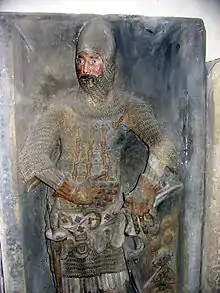 | 1297 | 1318–1340 | 28 July 1340 | County of Weimar (at Plassenburg) | Kunigunde of Leuchtenberg 1321 no children | Left no descendants. After his death his possessions were annexed by the House of Wettin. |
| Definitively annexed to the House of Wettin | |||||||
| Waldemar the Great |  |
1280 | 1305–1318 | 14 August 1319 | Margraviate of Brandenburg (at Neumark) |
Agnes of Brandenburg-Salzwedel (1297-27 November 1334) 1309 no children |
Son of Conrad, co-ruled with his uncles since 1308. Left no descendants, and the margraviate went to his underage cousin. |
| 1318–1319 | Margraviate of Brandenburg | ||||||
| Otto V[5] | c.1290 | 1319–1335 | 12 March 1335 | County of Weimar (at Lauenstein) | Helena of Nuremberg (1307–14 November 1378) 1321 three children |
Children of Herman IV, divided their rule. | |
| Frederick I the Elder | 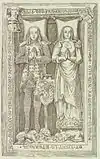 | c.1290 | 1319–1365 | 25 July 1365 | County of Weimar (at Weimar) | Elisabeth of Meissen (d. 2 May 1347) 1322 three children | |
| Regency of Wartislaw IV, Duke of Pomerania (1319–1320) | Son of Henry I. Died as a minor. After the extinction of the Ascanian dynasty in 1320, Brandenburg came under the control of the Emperor Louis IV of the House of Wittelsbach, who granted Brandenburg to his eldest son, Louis V of Bavaria. | ||||||
| Henry II the Child | 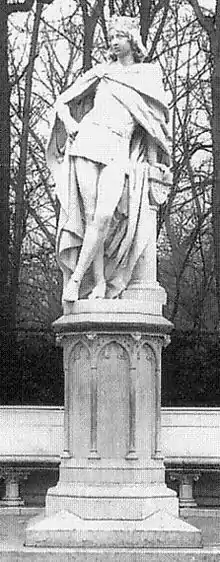 | 1302 | 1319–1320 | 26 March 1317 | Margraviate of Brandenburg | Unmarried | |
| Sophia | 1300 | 1320–1356 | 1356 | Margraviate of Brandenburg (at Landsberg) | Magnus I, Duke of Brunswick-Lüneburg 1327 eight children | After her death, the Margraviate of Landsberg was annexed to the Duchy of Brunswick-Lüneburg. | |
| Brandenburg definitively annexed to the House of Wittelsbach; Landsberg definitely annexed to the House of Welf | |||||||
| Regency of Elizabeth of Holstein-Rendsburg (1322–1330) | |||||||
| Albert IV | 1315 | 1322–1343 | 1343 | Saxe-Mölln | Beata of Schwerin 1334 three child Sophia of Mecklenburg-Werle-Güstrow 1341 no children | ||
| Bernard III | _-_gro%C3%9Fes_Reitersiegel.jpg.webp) | 1300 | 1323–1348 | 20 August 1348 | Anhalt-Bernburg | Agnes of Saxe-Wittenberg 1328 five children Matilda of Anhalt-Zerbst 1339 no children Matilda of Brunswick-Wolfenbüttel 1343 two children | |
| Frederick II | c.1321 | 1335–1368 | 14 October 1368 | County of Weimar (at Lauenstein)) | Sophia of Schwarzburg-Blankenburg (d.1392) 18 November 1357 two children | ||
| Eric II | 1318/20 | 1338–1368 | 1368 | Saxe-Ratzeburg | Agnes of Holstein-Plön between 1342 and 1349 four children | ||
| John III | c.1330 | 1343–1356 | 1356 | Saxe-Mölln | Unmarried | Left no descendants. He was succeeded by his brother, Albert. | |
| Bernard IV | _-_Secret.jpg.webp) | Before 1339 | 1348–1354 | 28 June 1354 | Anhalt-Bernburg | Unmarried | |
| Henry IV | Before 1339 | 1354–1374 | 7 July 1374 | Anhalt-Bernburg | Sophia of Stolberg before 1348 three children | Bypassed by his older brother Bernard IV as ruler of Anhalt-Bernburg, he only assumed rule of the principality when Bernhard died in 1354. | |
| Frederick III | c.1320 | 1354–1379 | 1379/80 | County of Orlamünde (at Schauenforst) | Unknown two children |
Children of Henry I, ruled jointly. In 1354, Orlamunde was annexed to the House of Wettin, and the family changed seat to Schauenforst, while Frederick's brother Henry II ruled from Droyssig. | |
| Henry II | c.1320 | 1354–1357 | 1357 | County of Orlamünde (at Droyssig) | Richeza of Henneberg (d.1379) six children | ||
| Albert V | c.1330 | 1356–1370 | 1370 | Saxe-Mölln | Catherine of Mecklenburg-Werle-Güstrow 25 January 1366 no children | Left no descendants. He was succeeded by his brother, Eric. | |
| Rudolph II the Blind (Rudolf II. der Blinde) | 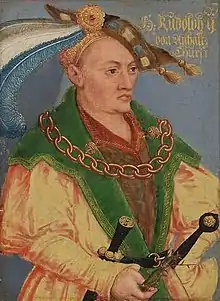 | 1307 | 12 March 1356 – 6 December 1370 | 6 December 1370 | Saxe-Wittenberg and Electorate of Saxony | Elisabeth of Hesse Before 8 May 1336 one child | Left no descendants. |
| Herman VI | c.1290 | 1365–1372 | 1372 | County of Weimar (at Weimar) | Catherine of Anhalt (d. 15 April 1369) 1328 two children |
Ruled jointly. Herman was Otto V and Frederick I's brother, and Frederick IV was Frederick I's son. After Herman's death Weimar was annexed to the House of Wettin. | |
| Frederick IV the Younger | c.1325 | 1365–1372 | 1381 | County of Weimar (at Weimar) | Irmgard no children | ||
| Definitively annexed to the House of Wettin | |||||||
| Otto VII |  | c.1360 | 1367–1405 | 1405 | County of Weimar (at Lauenstein)) | Liutgard of Gera (d.c.1410) c.1390 six children | |
| Wenceslaus I | 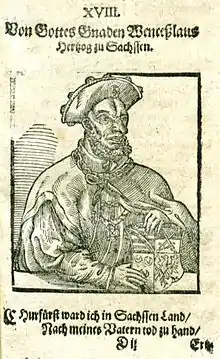 | 1337 | 6 December 1370 – 15 May 1388 | 15 May 1388 | Saxe-Wittenberg and Electorate of Saxony | Cecilia da Carrara 23 January 1376 six children | Brother of his predecessor. |
| Eric III | 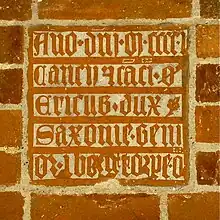 | c.1330 | 1370–1401 | 1401 | Saxe-Mölln | Unmarried | Determined to enter to clergy, has to resign to succeed his brothers. He also left no descendants, which allowed the Saxe-Ratzeburg-Lauenburg line to reunite Saxe-Lauenburg. |
| Otto III | Before 1348 | 1374–1404 | 27 February 1404 | Anhalt-Bernburg | Unknown two children Lutrudis before 1391 one child | Bypassed his nephew Bernard. | |
| Frederick V | c.1360? | 1379–1405 | c.1405 | County of Orlamünde (at Droyssig) | Catherine of Gleichen (d.28 June 1411) c.1380? two children | Son of Frederick III. Changed seat once more to Droyssig. | |
| Sigismund I | After 1366 | 1382–1405 | 19 January 1405 | Anhalt-Dessau (in Zerbst until 1396) | Judith of Querfurt 1386 eleven children |
Sons of John II. Ruled jointly. In 1396 divided the land. Sigismund received Anhalt-Dessau and Albert Anhalt-Köthen. | |
| Albert IV | After 1366 | 1382–1423 | 24 November 1423 | Anhalt-Köthen (in Zerbst until 1396) | Elisabeth of Mansfeld I before 1398 six children Elisabeth of Querfurt before 4 January 1419 three children | ||
| Valdemar III | After 1366 | 1382–1391 | 1391 | Anhalt-Zerbst | Unmarried | ||
| Rudolph III | .jpg.webp) | 1378 | 15 May 1388 – 11 June 1419 | 11 June 1419 | Saxe-Wittenberg and Electorate of Saxony | Anna of Meissen 1387/89 three children Barbara of Legnica March 1396 two children | Left no male descendants. he was succeeded by his brother, Albert. |
| In 1401 Saxe-Ratzeburg-Lauenburg inherited Saxe-Bergedorf-Mölln from the Ascanian Elder Lauenburg line there extinct upon Eric IV's death. The reunited duchy continued under the old name of Saxe-Lauenburg. | |||||||
| Eric IV | 1354 | 1368–1401 | 21 June 1411/12 | Saxe-Ratzeburg | Sophia of Brunswick-Lüneburg 8 April 1373 ten children |
In 1401 reunited Saxe-Lauenburg. | |
| 1401–1411/12 | Saxe-Lauenburg | ||||||
| Bernard V | Before 1374 | 1404–1420 | 24 June 1420 | Anhalt-Bernburg | Elisabeth of Hohnstein-Kelbra 8 September 1396 one child | Succeeded in reaching the pwer jointly with his eldest cousin, Otto. As he left no male heirs, the land was inherited by his other cousin, Bernard. | |
| Otto IV | Before 1391 | 1404–1415 | 7 July 1374 | Anhalt-Bernburg | Unmarried | Ruled jointly with his cousin. Left no descendants. | |
| George I the Elder | 1390 | 1405–1474 | 21 September 1474 | Anhalt-Dessau | Matilda of Anhalt-Bernburg I after 1413 no children Euphemia of Oleśnica 1432 six children Sophia of Hohnstein after 1442 three children Anna of Lindow-Ruppin 7 September 1453 nine children |
Sons of Sigismund I, ruled jointly. In 1468 inherited Anhalt-Bernburg. | |
| Albert V | After 1390 | 1405–1469 | 1469 | Anhalt-Dessau | Sophie of Hadmersleben no children | ||
| Valdemar IV | c.1386 | 1405–1417 | After 22 July 1417 | Anhalt-Dessau | Unmarried | ||
| Sigismund II | After 1390 | 1405–1452 | After 22 May 1452 | Anhalt-Dessau | Matilda of Anhalt-Bernburg II no children | ||
| William | c.1395 | 1405–1460 | 3 March 1460 | County of Weimar (at Lauenstein)) | Catherine of Blankenhain 1427 two children |
Children of Otto VII, divided their rule, which was progressively annexed to the House of Wettin. Elisabeth's seat went to the House of Reuss. | |
| Elisabeth (II) | c.1395 | 1405–1450 | c.1450 | County of Weimar (at Lauenstein)) | Henry XVII of Schwarzburg (d.1439) no children | ||
| Otto VIII | c.1395 | 1405–1460 | 1460 | County of Weimar (at Grafenthal) | Agnes of Beichlingen (d. 2 May 1347) 1322 three children | ||
| Sigismund | c.1395 | 1405–1447 | 2 July 1447 | County of Weimar (at Lichtenberg) | Unmarried | ||
| Definitively annexed to the House of Wettin | |||||||
| Henry III | c.1390? | 1405–1423 | 1423 | County of Orlamünde (at Droyssig) | Unmarried | Children of Frederick V, ruled jointly. After their childless deaths their possessions were annexed by the House of Wettin. | |
| Martin | c.1390? | 1405 | 1405 | County of Orlamünde (at Droyssig) | Unmarried | ||
| Definitively annexed to the House of Wettin | |||||||
| Eric V | after 1373 | 1411/12–1436 | 1436 | Saxe-Lauenburg | Elisabeth of Holstein-Rendsburg 1404 no children Elisabeth of Weinsberg before 1422 one child |
Ruled jointly. The numberings here lead to some confusion, as not all genealogists of the House of Ascania count John IV in the list of Dukes of Saxe-Lauenburg, numbering John V (John IV's nephew) as John IV. | |
| John IV | after 1373 | 1411/12–1414 | 1414 | Saxe-Lauenburg | Unmarried | ||
| Albert IV | .jpg.webp) | 1375/80 | 11 June 1419 – (before 12 November) 1422 | before 12 November 1422 | Saxe-Wittenberg and Electorate of Saxony | Euphemia of Oleśnica 14 January 1420 no children | Left no male descendants, which led the Ascanian Saxe-Wittenberg line to extinction. |
| The Ascanian Dynasty continued in Saxe-Lauenburg until 1689, but after the Lauenburgish line had finally lost the Saxon Electorate to the Wittenberg line in 1356 and failed to obtain the succession in the Electorate after 1422, recognition of the Dukes of Saxe-Lauenburg as Dukes of Saxony waned. To follow the remnant House of Ascania in Saxe-Lauenburg, follow this table. For the following Electors of Saxony, see below the House of Wettin. | |||||||
| Bernard VI | Before 1391 | 1420–1468 | 2 February 1468 | Anhalt-Bernburg | Matilda of Querfurt-Burgscheidungen 21 October 1419 two children Hedwig of Żagań 11 March 1434 no children | His children predeceased him, which left him no heirs at his death in 1468. Bernburg was inherited by Anhalt-Dessau line. | |
| Anhalt-Bernburg was annexed to Anhalt-Dessau | |||||||
| Adolph I | After 1398? | 1423–1473 | 28 August 1473 | Anhalt-Köthen | Cordula of Lindow-Ruppin 2 November 1442 Ruppin seven children |
Ruled jointly. Adolph ruled with his brother Valdemar V until 1436 and then with Valdemar's son John. In 1471, Adolph concluded a succession contract with George I, Prince of Anhalt-Dessau, which would put his youngest son in Köthen's throne, as Valdemar VI. | |
| Valdemar V | After 1398? | 1423–1436 | 28 August 1473 | Anhalt-Köthen | Sophie of Hadmersleben 1420 no children | ||
| John III | 1436–1463 | 1463 | Anhalt-Köthen | Unmarried | |||
| Bernard IV | 1385/93 | 1436–1463 | 16 July 1463 | Saxe-Lauenburg | Adelaide of Pomerania-Stolp 1428 two children | ||
| John V | 18 July 1439 | 1463–1507 | 15 August 1507 | Saxe-Lauenburg | Dorothea of Brandenburg 12 February 1464 twelve children | Sometimes numbered John IV. He is sometimes confused with his uncle, John IV (Eric V and Bernard IV's brother) and a son of his own (John IV, Bishop of Hildesheim). | |
| Valdemar VI | 1450 | 1473–1508 | 1 November 1508 | Anhalt-Köthen | Margaret of Schwarzburg 24 January 1485 Köthen four children |
After the contract established with Dessau, this line of princes dominated in Köthen. After the death of Adolph in 1473, George I of Dessau's sons, Valdemar VI and Albert VI, ascended to the principality. After Albert's death, Valdemar co-ruled with his nephews. In 1508, all his co-rulers abdicated to Valdemar VI's son, Wolfgang. | |
| Albert VI | After 1419? | 1473–1475 | 9 January 1475 | Anhalt-Köthen | Elisabeth of Mansfeld II 27 March 1454 Alsleben seven children | ||
| Philip | 31 May 1468 | 1475–1500 | 13 November 1500 | Anhalt-Köthen | Unmarried | ||
| Magnus | 1455 | 1475–1508 | 29 October 1524 | Anhalt-Köthen | Unmarried | ||
| Adolph II | 16 October 1458 | 24 March 1526 | Anhalt-Köthen | Unmarried | |||
| Ernest I | 1454 | 1474–1516 | 12 June 1516 | Anhalt-Dessau | Margaret of Münsterberg 20 January 1494 Cottbus four children |
Sons of George I, ruled jointly. | |
| George II the Strong | 1454 | 1474–1509 | 25 April 1509 | Anhalt-Dessau | Agnes of Pomerania-Barth 1478 no children | ||
| Sigismund III | 1456 | 1474–1487 | 27 November 1487 | Anhalt-Dessau | Unmarried | ||
| Rudolph I the Valiant | 1466 | 1474–1510 | 7 September 1510 | Anhalt-Dessau | Unmarried | ||
| Magnus I |  | 1 January 1470 | 1507–1543 | 1 August 1543 | Saxe-Lauenburg | Catherine of Brunswick-Wolfenbüttel 20 November 1509 Wolfenbüttel six children | |
| Wolfgang the Confessor |  | 1 August 1492 | 1508–1562 | 23 March 1566 | Anhalt-Köthen | Unmarried | Sole ruler of Köthen. After his abdication without descendants, the Principality was incorporated in the recreated Anhalt-Zerbst. |
| Regency of Margaret of Münsterberg (1516–1524) | Children of Ernest I, ruled jointly, firstly under their mother. In 1544, the brothers divided the land. Joachim mainteined Dessau to himself; John took Zerbst and refounded Anhalt-Zerbst; George took Plotzkau. After George and Joachim's deaths without descendants, their lands were inherited by their nephews, sons of John III. | ||||||
| Joachim I | .jpg.webp) | 7 August 1509 | 1516–1561 | 6 December 1561 | Anhalt-Dessau | Unmarried | |
| John IV | .jpg.webp) | 4 September 1504 | 1516–1551 | 4 February 1551 | Anhalt-Zerbst (in Dessau until 1544) | Margaret of Brandenburg 15 February 1534 Dessau six children | |
| George III the God-Blessed | 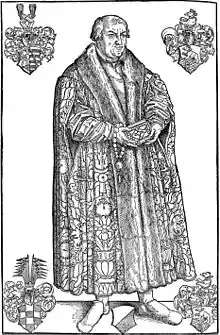 | 15 August 1507 | 1516–1553 | 17 October 1553 | Anhalt-Plotzkau (in Dessau until 1544) | Unmarried | |
| Francis I | 1510 | 1543–1571 | 19 March 1581 | Saxe-Lauenburg | Sibylle of Saxony 8 February 1540 Dresden nine children | In 1571 – highly indebted – Francis I resigned in favour of his eldest son Magnus II, who had promised to redeem the pawned ducal demesnes with funds he gained as Swedish military commander and by his marriage to a Swedish princess. | |
| Charles I | 17 November 1534 | 1551–1561 | 4 May 1561 | Anhalt-Zerbst | Anna of Pomerania 16 May 1557 Zerbst no children |
Sons of John IV. In 1553 inherited Plotzkau from their uncle George III. In 1561 inherited Dessau and Bernburg from their uncle Joachim. In the next year inherited Kothen. From 1570 Joachim Ernest was the sole owner of all Anhalt. | |
| Joachim Ernest | 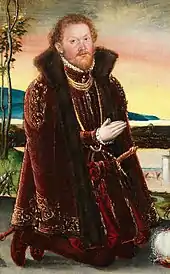 |
21 October 1536 | 1551–1562 | 6 December 1586 | Anhalt-Zerbst | Agnes of Barby-Mühlingen 3 March 1560 Barby six children Eleonore of Württemberg 9 January 1571 Stuttgart ten children | |
| 1562–1586 | Anhalt | ||||||
| Bernard VII | 17 March 1540 | 1551–1562 | 1 March 1570 | Anhalt-Zerbst | Clara of Brunswick-Lüneburg-Gifhorn 28 May 1565 Dessau one child | ||
| 1562–1570 | Anhalt | ||||||
| Magnus II | 1543 | 1571–1573 | 14 March 1603 | Saxe-Lauenburg | Sophia of Sweden 4 July 1568 Stockholm one child | Eldest son of Francis I. He didn't pay the debts he promised to pay and led to war with his father and brothers. Two years later they deposed Magnus II and Francis I re-ascended. Magnus' violent and judicial attempts to regain the duchy failed. In 1588 he was imprisoned for the remainder of his life. | |
| Francis I | 1510 | 1573–1581 | 19 March 1581 | Saxe-Lauenburg | Sibylle of Saxony 8 February 1540 Dresden nine children | Regained the title in 1573, after pushing back Magnus II. | |
| Francis II |  | 10 August 1547 | 1581–1619 | 2 July 1619 | Saxe-Lauenburg | Margaret of Pomerania-Wolgast 26 December 1574 Wolgast four children Maria of Brunswick-Wolfenbüttel 10 November 1582 Wolfenbüttel fourteen children | Brother of Magnus II. Vice-regent from 1578, administrator from 1581. Joint rule with his brother Maurice between 1581 and 1612. Father of Augustus and Julius Henry. |
| Maurice | 1551 | 1581–1612 | 2 November 1612 | Saxe-Lauenburg | Katharina von Spörck 1581 (annulled 1582) no children | Ruled jointly with his brother Francis II. | |
| John George I | .JPG.webp) |
9 May 1567 | 1586–1603 | 24 May 1618 | Anhalt | Dorothea of Mansfeld-Arnstein 22 February 1588 Hedersleben five children Dorothea of Palatinate-Simmern 21 February 1595 Heidelberg eleven children |
Sons of Joachim Ernest, ruled jointly. In 1603 divided the land again: John George received Dessau; Christian received Bernburg; Augustus received Plötzkau; Rudolph received Zerbst; Louis received Köthen. Augustus served also as regent for his minor nephews in Anhalt-Kothen and Anhalt-Zerbst. |
| 1603–1618 | Anhalt-Dessau | ||||||
| Christian I | 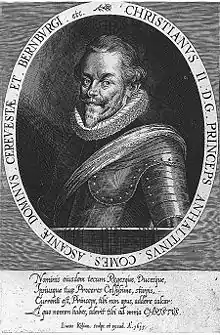 |
11 May 1568 | 1586–1603 | 17 April 1630 | Anhalt | Anna of Bentheim-Steinfurt-Tecklenburg-Limburg 2 July 1595 Lorbach sixteen children | |
| 1603–1630 | Anhalt-Bernburg | ||||||
| Rudolph II | .jpg.webp) |
28 October 1576 | 1586–1603 | 30 July 1621 | Anhalt | Dorothea Hedwig of Brunswick-Wolfenbüttel 29 December 1605 Wolfenbüttel four children | |
| 1603–1621 | Anhalt-Zerbst | ||||||
| Louis I | 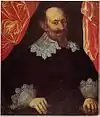 |
17 June 1579 | 1586–1603 | 7 January 1650 | Anhalt | Amöena Amalie of Bentheim-Steinfurt-Tecklenburg-Limburg 31 October 1606 Rheda two children Sophia of Lippe 12 September 1626 Detmold two children | |
| 1603–1650 | Anhalt-Köthen | ||||||
| Augustus | 14 July 1575 | 1586–1603 | 22 August 1653 | Anhalt | Sibylle of Solms-Laubach 25 January 1618 Ansbach eight children | ||
| 1603–1653 | Anhalt-Plötzkau | ||||||
| John Casimir |  | 17 December 1596 | 1618–1660 | 15 September 1660 | Anhalt-Dessau | Agnes of Hesse-Kassel 18 May 1623 Dessau six children Sophie Margaret of Anhalt-Bernburg 14 July 1651 Dessau no children | |
| Augustus | 17 February 1577 | 1619–1656 | 18 January 1656 | Saxe-Lauenburg | Elisabeth Sofie of Holstein-Gottorp 5 March 1621 Husum six children Catherine of Oldenburg 4 June 1633 no children | Left no male descendants; he was succeeded by his half-brother Julius Henry. | |
| Regency of Augustus, Prince of Anhalt-Plötzkau (1621–1642) | |||||||
| John V |  | 24 March 1621 | 1621–1667 | 4 July 1667 | Anhalt-Zerbst | Sophie Augusta of Holstein-Gottorp 16 September 1649 Gottorp fourteen children | |
| Christian II | .jpg.webp) | 11 August 1599 | 1630–1656 | 22 September 1656 | Anhalt-Bernburg | Eleonore Sophie of Schleswig-Holstein-Sonderburg-Plön 28 February 1625 Ahrensbök fifteen children | |
| Frederick |  | 16 November 1613 | 1630–1670 | 30 June 1670 | Anhalt-Bernburg (at Harzgerode) | Johanna Elisabeth of Nassau-Hadamar 10 August 1642 Bückeburg three children Anna Katharina of Lippe-Detmold (31 July 1612 – 15 October 1659) 26 May 1657 Harzgerode no children | |
| Regency of Augustus, Prince of Anhalt-Plötzkau, Lebrecht, Prince of Anhalt-Köthen and Emmanuel, Prince of Anhalt-Köthen (1650–1653) | After his death without descendants, his previous regents took over the principality for themselves. | ||||||
| William Louis | 3 August 1638 | 1650–1665 | 13 April 1665 | Anhalt-Köthen | Elisabeth Charlotte of Anhalt-Harzgerode 25 August 1663 Köthen no children | ||
| Lebrecht I | .jpg.webp) |
8 April 1622 | 1653–1665 | 7 November 1669 | Anhalt-Plötzkau | Sophie Ursula Eleonore of Stolberg-Wernigerode 18 January 1655 Plötzkau no children |
Cousins of William Louis, and princes of Anhalt-Plötzkau, they served as regents for their cousin alongside their uncle, Augustus. After William Louis' death in 1665, they took the principality of Köthen for themselves, giving away their inheritance in Plötzkau to Anhalt-Bernburg. |
| 1665–1669 | Anhalt-Köthen | ||||||
| Emmanuel |  |
6 October 1631 | 1653–1665 | 8 November 1670 | Anhalt-Plötzkau | Anna Eleonore of Stolberg-Wernigerode 23 March 1670 Ilsenburg one child | |
| 1665–1670 | Anhalt-Köthen | ||||||
| Plotzkau definitively annexed to the Principality of Anhalt-Bernburg | |||||||
| Victor Amadeus |  | 6 October 1634 | 1656–1718 | 14 February 1718 | Anhalt-Bernburg | Elisabeth of Palatinate-Zweibrücken 16 October 1667 Meisenheim six children | Annexed Anhalt-Plötzkau in 1665. |
| Julius Henry |  | 9 April 1586 | 1656–1665 | 20 November 1665 | Saxe-Lauenburg | Anna of East Frisia 17 March 1617 Grabow no children Elisabeth Sophia of Brandenburg 4 June 1633 Toužim one son Anna Magdalena of Lobkowicz 18 August 1632 Vienna six children | |
| John George II |  | 17 November 1627 | 1660–1693 | 7 August 1693 | Anhalt-Dessau | Henriette Catherine of Nassau 9 September 1659 Groningen five children | Prince of Anhalt-Dessau, he also served as regent for his cousin, Emmanuel Lebrecht of Anhalt-Kothen, together with the prince's mother, Anna Eleonore of Stolberg-Wernigerode. |
| Francis Erdmann | 25 February 1629 | 1665–1666 | 30 July 1666 | Saxe-Lauenburg | Sibylle Hedwig of Saxe-Lauenburg 1654 no children | Left no descendants; He was succeeded by his brother Julius Francis. | |
| Julius Francis |  | 16 September 1641 | 1666–1689 | 30 September 1689 | Saxe-Lauenburg | Hedwig of the Palatinate-Sulzbach 9 April 1668 Sulzbach two children | |
| Definitively annexed to the House of Welf | |||||||
| Regency of Sophie Augusta of Holstein-Gottorp (1667–1674) | Children of John V, divided the rule. | ||||||
| Charles William |  | 16 October 1652 | 1667–1718 | 3 November 1718 | Anhalt-Zerbst | Sophia of Saxe-Weissenfels 18 June 1676 Halle three children | |
| John Louis I | 4 May 1656 | 1667–1704 | 1 November 1704 | Anhalt-Zerbst (at Dornburg) | Christine Eleonore of Zeutsch (5 June 1666 – 17 May 1699) 23 July 1687 Halle seven children | ||
| Regencies of Anna Eleonore of Stolberg-Wernigerode (1670–1690) and John George II, Prince of Anhalt-Dessau (1690–1692) | |||||||
| Emmanuel Lebrecht | .jpg.webp) | 20 May 1671 | 1670–1704 | 30 May 1704 | Anhalt-Köthen | Gisela Agnes of Rath 30 September 1692 Nienburg (morganatic) ten children | |
| William Louis |  | 18 August 1643 | 1670–1709 | 14 October 1709 | Anhalt-Bernburg (at Harzgerode) | Elisabeth Juliana of Solms-Laubach (6 March 1631 – 2 January 1693)25 July 1671 Laubach no children Sophie Auguste of Nassau-Dillenburg (28 April 1666 – 14 January 1733) 20 October 1695 Frederiksborg no children | After his death, Harzgerode merged again in Bernburg. |
| Regency of Henriette Catherine of Nassau (1693–1698) | |||||||
| Leopold I |  | 3 July 1676 | 1693–1747 | 7 April 1747 | Anhalt-Dessau | Anna Louise Föhse 8 September 1698 Dessau (morganatic) ten children | |
| Regency of Gisela Agnes of Rath (1704–1715) | With no male heirs, he was succeeded by his brother. | ||||||
| Leopold | .jpg.webp) | 29 November 1694 | 1704–1728 | 19 November 1728 | Anhalt-Köthen | Frederica Henriette of Anhalt-Bernburg 11 December 1721 Bernburg one child Charlotte Frederike of Nassau-Siegen 27 June 1725 Weimar two children | |
| Charles Frederick | .jpg.webp) | 13 July 1668 | 1718–1721 | 22 April 1721 | Anhalt-Bernburg | Sophie Albertine of Solms-Sonnenwalde 25 June 1692 Bernburg six children Wilhelmine Charlotte Nüssler 1 May 1715 Bernburg |
Children of Victor Amadeus, divided their rule. |
| Lebrecht | .jpg.webp) | 28 June 1669 | 1718–1727 | 17 May 1727 | Anhalt-Bernburg (in Zeitz-Hoym) | Charlotte of Nassau-Schaumburg Schaumburg Castle 12 April 1692 five children Eberhardine of Weede (9 August 1685 – 13 February 1724) 27 June 1702 Grave six children Sophie Sibylla of Ingersleben (18 March 1684 – 31 March 1726) 14 September 1725 (morganatic) no children | |
| John Augustus |  | 29 July 1677 | 1718–1742 | 7 November 1742 | Anhalt-Zerbst | Fredericka of Saxe-Gotha-Altenburg 25 May 1702 Zerbst no children | Died without issue. Zerbst was inherited by his cousins from Dornburg. |
| Victor Frederick |  | 20 September 1700 | 1721–1765 | 18 May 1765 | Anhalt-Bernburg | Louise of Anhalt-Dessau 25 November 1724 Dessau one child Sophie Albertine Fredericka of Brandenburg-Schwedt 22 May 1733 Potsdam five children Konstanze Fredericka Schmidt 13 November 1750 Bernburg (morganatic) one child | |
| Victor I Amadeus |  | 7 September 1693 | 1727–1772 | 15 April 1772 | Anhalt-Bernburg (in Zeitz-Hoym in 1727; in Schaumburg-Hoym from 1727) | Charlotte Louise of Isenburg-Birstein (31 July 1680 – 2 January 1739) 22 November 1714 Birstein six children Hedwig Sophie Henckel of Donnersmarck 14 February 1740 Pölzig six children | |
| Augustus Louis | 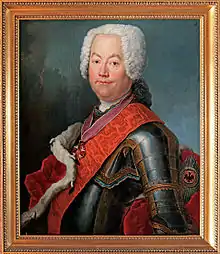 | 9 June 1697 | 1728–1755 | 6 August 1755 | Anhalt-Köthen | Agnes Wilhelmine von Wuthenau 23 January 1722 Dresden (morganatic) two children Christine Johanna Emilie of Promnitz-Pless 14 January 1726 Sorau five children Anna Fredericka of Promnitz-Pless 21 November 1732 Sorau two children | |
| John Louis | 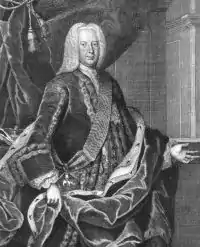 | 23 June 1688 | 1704–1746 1742–1746 | 5 November 1746 | Anhalt-Zerbst (in Dornburg) Anhalt-Zerbst | Unmarried | First cousins of their predecessor, they were Princes of Dornburg, until its ending by joining it with the inherited Principality of Zerbst. Ruled jointly. after John Louis' death, Christian ruled alone. |
| Christian August | .jpg.webp) | 29 November 1690 | 1704–1747 1742–1747 | 16 March 1747 | Anhalt-Zerbst (in Dornburg) Anhalt-Zerbst | Joanna Elisabeth of Holstein-Gottorp 8 November 1727 Vechelde five children | |
| Christian Louis | 5 November 1691 | 1704–1710 | 20 October 1710 | Anhalt-Zerbst (in Dornburg) | Unmarried | ||
| John Frederick | 14 July 1695 | 1704–1742 | 11 May 1742 | Anhalt-Zerbst (in Dornburg) | Cajetana of Sperling (d.17 December 1742) no children | ||
| Leopold II Maximilian | 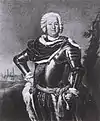 | 25 December 1700 | 1747–1751 | 16 December 1751 | Anhalt-Dessau | Gisela Agnes of Anhalt-Köthen 25 May 1737 Bernburg seven children | |
| Regency of Joanna Elisabeth of Holstein-Gottorp (1747–1752) | |||||||
| Frederick August | 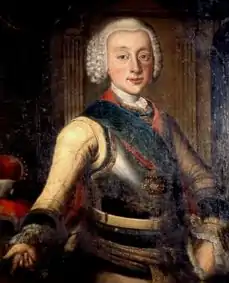 | 8 August 1734 | 1747–1793 | 3 March 1793 | Anhalt-Zerbst | Caroline Wilhelmina Sophia of Hesse-Kassel 17 November 1753 Zerbst no children Friederike Auguste Sophie of Anhalt-Bernburg 22 May 1764 Ballenstedt no children | |
| Definitively annexed by the Principality of Anhalt-Dessau | |||||||
| Regency of Dietrich of Anhalt-Dessau (1751–1758) | Prince of Anhalt-Dessau, also served as regent for his cousin, Louis Augustus Karl Frederick Emil of Anhalt-Kothen. After his death the regency in Anhalt-Kothen passed together with the principality of Anhalt-Dessau to his son. | ||||||
| Leopold III Frederick Franz | 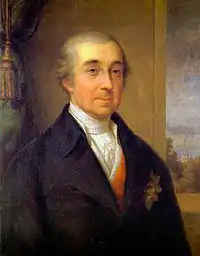 | 10 August 1740 | 1751–1817 | 9 August 1817 | Anhalt-Dessau | Louise Henriette Wilhelmine of Brandenburg-Schwedt 25 July 1767 Charlottenburg two children | |
| Charles George Lebrecht | .jpg.webp) | 15 August 1730 | 1755–1789 | 17 October 1789 | Anhalt-Köthen | Louise Charlotte of Schleswig-Holstein-Sonderburg-Glücksburg 26 July 1763 Glücksburg six children | |
| Frederick Albert | 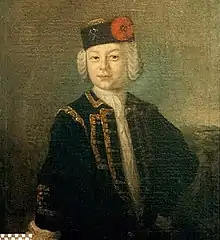 | 15 August 1735 | 1765–1796 | 9 April 1796 | Anhalt-Bernburg | Louise Albertine of Schleswig-Holstein-Sonderburg-Plön 25 November 1724 Augustenburg two children | |
| Charles Louis | 16 May 1723 | 1772–1806 | 20 August 1806 | Anhalt-Bernburg (in Schaumburg-Hoym) | Benjamine Gertrude Keiser (1 January 1729 – 6 January 1787) 25 March 1748 Stevensweert (morganatic) Amalia Eleonora of Solms-Braunfels (22 November 1734 – 19 April 1811) 12 December 1765 Braunfels five children | ||
| Augustus Christian Frederick | 18 November 1769 | 1789–1812 | 5 May 1812 | Anhalt-Köthen | Fredericka of Nassau-Usingen 9 February 1792 Frankfurt-am-Main no children | In 1806 became Duke of Anhalt-Köthen. Left no descendants, and was succeeded by his nephew. | |
| Alexius Frederick Christian |  | 12 June 1767 | 1796–1834 | 24 March 1834 | Anhalt-Bernburg | Marie Friederike of Hesse-Kassel 29 November 1794 Kassel (annulled 1817) four children Dorothea Fredericka of Sonnenberg 11 January 1818 Ballenstedt (morganatic) no children Ernestine Charlotte of Sonnenberg 2 May 1819 Bernburg (morganatic) no children | In 1803 became Duke of Anhalt-Bernburg. |
| Victor II Charles | 2 November 1767 | 1806–1812 | 22 April 1812 | Anhalt-Bernburg (in Schaumburg-Hoym) | Amelia of Nassau-Weilburg 29 October 1793 Weilburg four children | ||
| Regencies of Leopold III, Duke of Anhalt-Dessau (1812–1817) and Leopold IV, Duke of Anhalt (1817–1818) | Died as a minor, never ruled by his own. | ||||||
| Louis Augustus Karl | 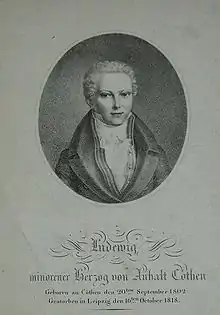 | 20 September 1802 | 1812–1818 | 18 December 1818 | Anhalt-Köthen | Louise Charlotte of Schleswig-Holstein-Sonderburg-Glücksburg 26 July 1763 Glücksburg six children | |
| Frederick | 29 November 1741 | 1812 | 24 December 1812 | Anhalt-Bernburg (in Schaumburg-Hoym) | Unmarried | Son of Victor I. AFter his childless death, Hoym and Holzappel were inherited by his niece Hermine (daughter of Victor II), while Hoym merged in Bernburg again. | |
| Hermine | 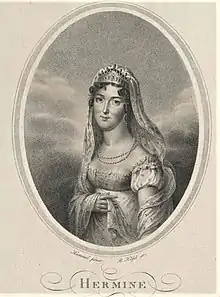 | 2 December 1797 | 1812–1817 | 14 September 1817 | Anhalt-Bernburg (in Schaumburg and Holzappel) | Archduke Joseph, Palatine of Hungary 30 August 1815 Schaumburg Castle two children | Daughter of Victor II. After her death her lands probably merged again in Bernburg. |
| Frederick Ferdinand |  | 25 June 1769 | 1818–1830 | 23 August 1830 | Anhalt-Köthen | Maria Dorothea Henriette Louise of Schleswig-Holstein-Sonderburg-Beck 26 July 1763 Lindenau bei Heiligenbeil no children Julie of Brandenburg 20 May 1816 Berlin no children | From the Anhalt-Pless line, cousin of his predecessor. Attempted, with no success, to reinstall Catholicism in his duchy. |
| Henry |  | 30 July 1778 | 1830–1847 | 23 November 1847 | Anhalt-Köthen | Auguste Fredericka Espérance Reuss of Köstritz 18 May 1819 Trebschen no children | Left no descendants. His lands were inherited by Leopold of Anhalt-Dessau. |
| Definitively annexed to the Principality of Anhalt-Dessau | |||||||
| Alexander Charles | .jpg.webp) | 2 March 1805 | 1834–1863 | 19 August 1863 | Anhalt-Bernburg | Friederike of Schleswig-Holstein-Sonderburg-Glücksburg 30 October 1834 Gottorp no children | Left no male descendants. Bernburg reverted to Anhalt-Dessau. |
| Definitively annexed to the Principality of Anhalt-Dessau | |||||||
| Leopold IV Frederick | 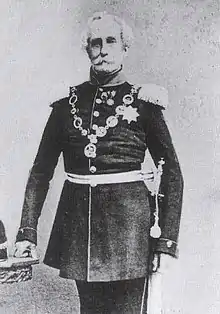 |
1 October 1794 | 1817–1863 | 22 May 1871 | Anhalt-Dessau | Frederica Wilhelmina of Prussia 18 April 1818 Berlin six children |
Prince of Anhalt-Dessau, ended the regency in Kothen after his cousin's death (1818). In 1863 he reunites Anhalt under his rule, and becomes its first duke. |
| 1863–1871 | Anhalt | ||||||
| Frederick I |  | 29 April 1831 | 1871–1904 | 24 January 1904 | Anhalt | Antoinette of Saxe-Altenburg 22 April 1854 Altenburg six children | |
| Frederick II | 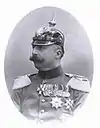 | 19 August 1856 | 1904–1918 | 21 April 1918 | Anhalt | Marie of Baden 2 July 1889 Karlsruhe no children | Left no descendants. He was succeeded by his brother. |
| Edward | 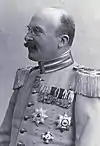 | 18 April 1861 | 1918 | 13 September 1918 | Anhalt | Louise Charlotte of Saxe-Altenburg 6 February 1895 Altenburg (annulled 26 January 1918) six children | Brother of his predecessor. Ruled 18 April to 13 September. |
| Joachim Ernest II | 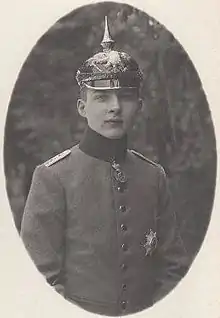 | 11 January 1901 | 1918 | 18 February 1947 | Anhalt | Elisabeth Strickrodt 3 March 1927 Ballenstedt (morganatic, annulled 1929) no children Edda-Charlotte von Stephani-Marwitz 15 October 1929 Ballenstedt (morganatic) five children | Ruled 13 September to 12 November. Monarchy abolished in that year. |
Family trees
(genealogical list of the dynasty in German)
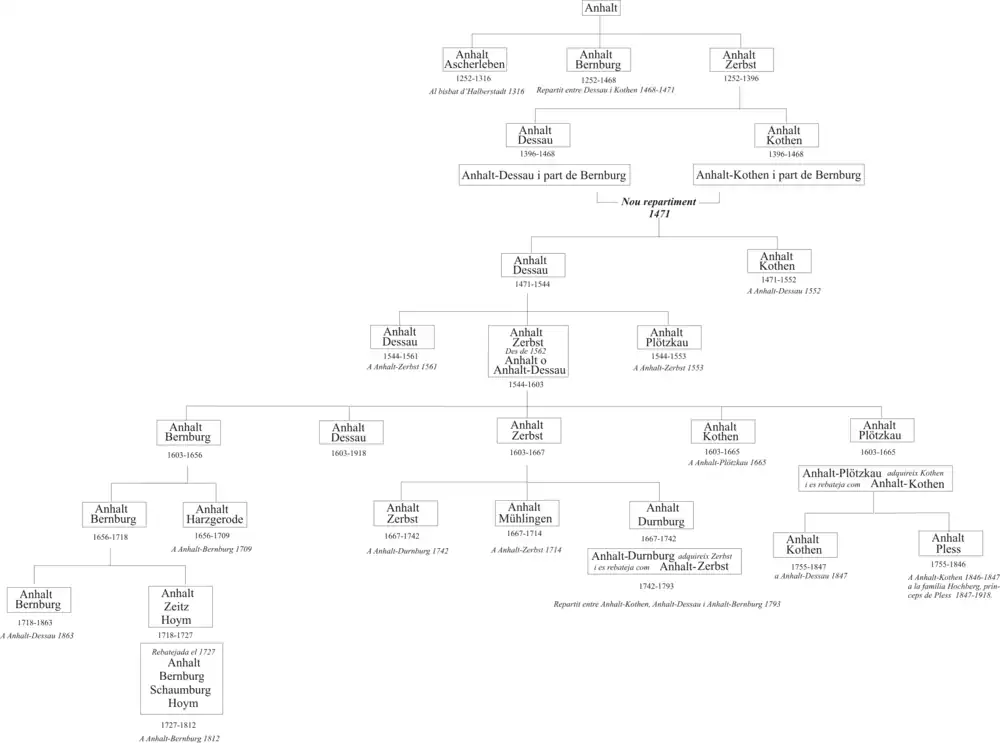
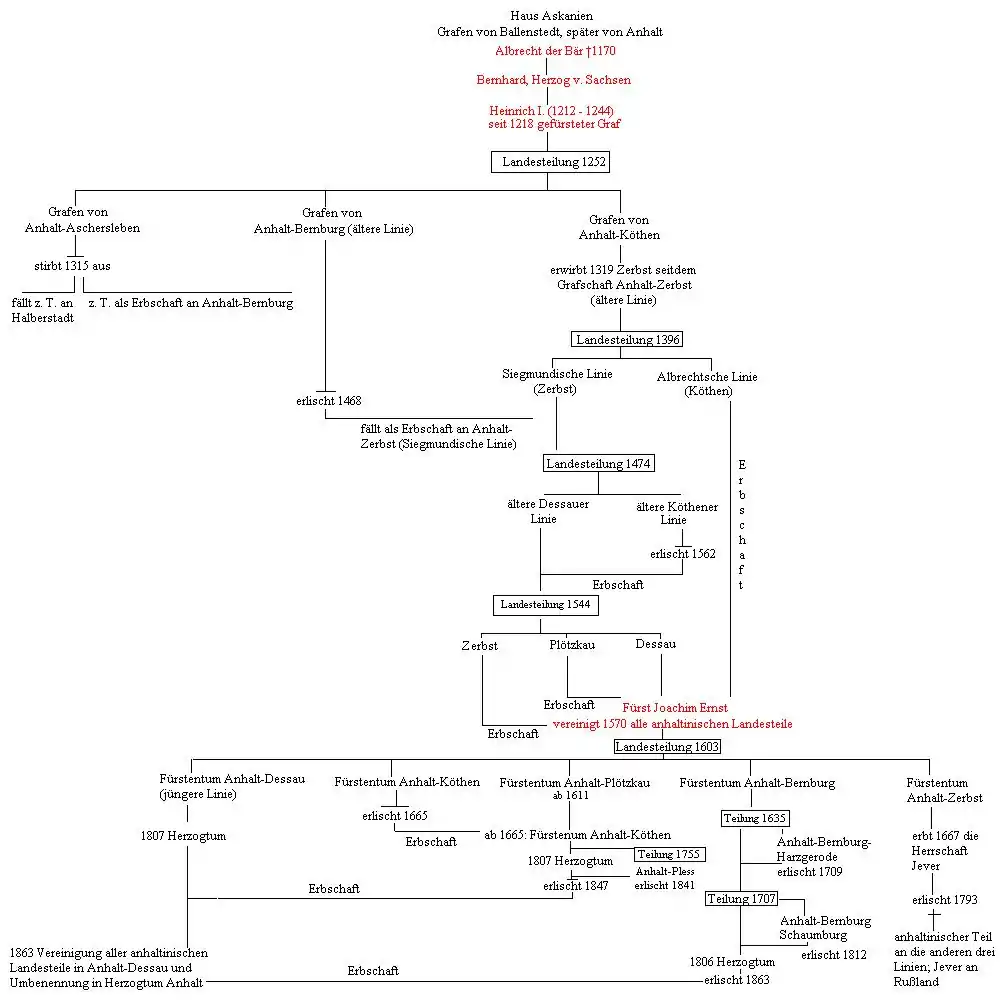
Armorial
The original arms of the house of Ascania, from their ancestors the Saxon counts of Ballenstedt, were "Barry of ten sable and or".
The Ascanian margrave Albert the Bear was invested with the Saxon ducal title in 1138; when he succeeded the Welf's Henry the Lion, who was deposed by Emperor Frederick Barbarossa. In 1180, Albert's son Bernhard, Count of Anhalt received the remaining Saxon territories around Wittenberg and Lauenburg, and the ducal title. Legend, so unlikely to be true, goes that when he rode in front of the emperor, at the occasion of his investiture, he carried a shield with his escutcheon of the Ballenstedt coat of arms (barry sable and or). Barbarossa took the rue wreath he wore against the heat of the sun from his head, hanging it over Bernhard's shield and thus creating the Saxonian crancelin vert ("Barry of ten sable and or, a crancelin vert"). A more likely explanation is that it probably symbolized the waiver of the Lauenburg lands.[6]
From about 1260, the Duchy of Saxe-Wittenberg emerged under the Ascanian duke Albert II, who adopted the tradition of the Saxon stem duchy and was granted the Saxon electoral dignity, against the fierce protest of his Ascanian Saxe-Lauenburg cousins. This was confirmed by the Golden Bull of 1356. As the Ascanian Electors of Saxony also held the High office of an Arch-Marshal of the Holy Roman Empire, they added the ensign Per fess sable and argent two swords in saltire gules (the swords later featuring as the trademark of the Meissen china factory) to their coat of arms. When the line became extinct in 1422, the arms and electoral dignity were adopted by the Wettin by margrave Frederick IV of Meissen as it had become synonymous with the Saxon ducal title.
When upon German reunification the Free State of Saxony was re-established, the coat of arms was formally confirmed in 1991. [7]
.svg.png.webp) Original Arms of counts of Ballenstedt
Original Arms of counts of Ballenstedt Arms of Ascania impaled with the Mark of Brandenburg
Arms of Ascania impaled with the Mark of Brandenburg.svg.png.webp) Arms of Ascania impaled with the Mark of Brandenburg
Arms of Ascania impaled with the Mark of Brandenburg
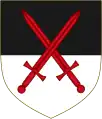 Arms of the Arch-Marshal/prince elector of the Saxons of the Holy Roman Empire
Arms of the Arch-Marshal/prince elector of the Saxons of the Holy Roman Empire Arms of the Elector/Duke of Saxony (Saxe-Wittenburg)
Arms of the Elector/Duke of Saxony (Saxe-Wittenburg)
.svg.png.webp) Principality of Anhalt in the 15th century
Principality of Anhalt in the 15th century.svg.png.webp) Principalities of Anhalt in the 17th century
Principalities of Anhalt in the 17th century.svg.png.webp) Principality of Anhalt-Köthen in the 18th century
Principality of Anhalt-Köthen in the 18th century.svg.png.webp) Principality of Anhalt-Zerbst in the 19th century
Principality of Anhalt-Zerbst in the 19th century Coat of Arms of the Duchy of Anhalt
Coat of Arms of the Duchy of Anhalt Achievement of the Duchy of Anhalt
Achievement of the Duchy of Anhalt
The chivalric order was the House Order of Albert the Bear (German: Hausorden Albrechts des Bären or Der Herzoglich Anhaltische Hausorden Albrechts des Bären) which was founded in 1836 as a joint House Order by three dukes of Anhalt from separate branches of the family: Henry, Duke of Anhalt-Köthen, Leopold IV, Duke of Anhalt-Dessau, and Alexander Karl, Duke of Anhalt-Bernburg.
The namesake of the order, Albert the Bear, was the first Margrave of Brandenburg from the House of Ascania. The origin of his nickname "the Bear" is unknown.
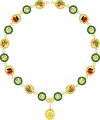 Collar of the Order of Albert the Bear
Collar of the Order of Albert the Bear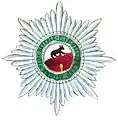 Star of the Order of Albert the Bear
Star of the Order of Albert the Bear House Order of Albert the Bear
House Order of Albert the Bear
List of states ruled by the House of Ascania
 Saxony in 1180 with the Ascanian duchies in Saxony around 1235 (green). The former stem Duchy of Saxony is in gold with the official electorate duchy of Saxe-Wittenberg in green in the South East. Also shown is Saxe-Lauenburg in North West and the Welf Duchies of Brunswick-Luneburg in orange.
Saxony in 1180 with the Ascanian duchies in Saxony around 1235 (green). The former stem Duchy of Saxony is in gold with the official electorate duchy of Saxe-Wittenberg in green in the South East. Also shown is Saxe-Lauenburg in North West and the Welf Duchies of Brunswick-Luneburg in orange. The Duchy of Saxe-Lauenburg in 1400
The Duchy of Saxe-Lauenburg in 1400 Duchy of Saxe-Wittenberg (dark green, centred on the town of Wittenberg)
Duchy of Saxe-Wittenberg (dark green, centred on the town of Wittenberg) Brandenburg in 1320 under the Ascanians
Brandenburg in 1320 under the Ascanians The Duchy of Anhalt, bordered by Prussia und Duchy of Brunswick-Luneburg
The Duchy of Anhalt, bordered by Prussia und Duchy of Brunswick-Luneburg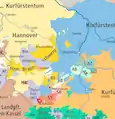 Anhalt Principalities in 1789: Anhalt-Bernburg (AB), Anhalt-Köthen (AK), Anhalt-Dessau (AD) and Anhalt-Zerbst (AZ); on the rightside of the map: the Electorate of Brandenburg (blue) und Electorate of Saxony (orange)
Anhalt Principalities in 1789: Anhalt-Bernburg (AB), Anhalt-Köthen (AK), Anhalt-Dessau (AD) and Anhalt-Zerbst (AZ); on the rightside of the map: the Electorate of Brandenburg (blue) und Electorate of Saxony (orange)
- County, Principality, and Duchy of Anhalt: c. 1100–1918
- Duchy and Electorate of Saxony: 1112, 1139–1142, 1180–1422
- County of Weimar-Orlamünde: 1112–1486
- Margravate of Brandenburg: 1157–1320
- Duchy of Saxe-Lauenburg: 1269–1689
- Principality of Lüneburg: 1369–1388
- Principality and Duchy of Anhalt-Bernburg: 1252–1468 and 1603–1863
- Principality of Anhalt-Zerbst: 1252–1396 and 1544–1796
- Principality of Anhalt-Aschersleben: 1252–1315
- Principality and Duchy of Anhalt-Köthen: 1396–1561 and 1603–1847
- Principality and Duchy of Anhalt-Dessau 1396–1561 and 1603–1863
- Principality of Anhalt-Plötzkau 1544–1553 and 1603–1665
- Principality of Anhalt-Harzgerode 1635–1709
- Principality of Anhalt-Mühlingen: 1667–1714
- Principality of Anhalt-Dornburg: 1667–1742
- Lordship of Jever: 1667–1796
- Principality of Anhalt-Bernburg-Schaumburg-Hoym: 1718–1812
- Russian Empire: 1762–1796
References
- Askanien, Meyers Konversationslexikon, 1888
- Trillmich, Werner, Kaiser Konrad II. und seine Zeit, Bonn, 1991
- Hiebl, Manfred (2006). "Das Haus Askanien-Anhalt, dessen Zweige und ihre Bedeutung". www.manfred-hiebl.de. Retrieved 2020-08-29.
- "Ascania 1". genealogy.euweb.cz. 2003-08-01. Retrieved 2020-08-29.
- hrsg. von Werner Paravicini. Bearb. von Jan Hirschbiegel. "Askanier". Höfe und Residenzen im spätmittelalterlichen Reich Bd. 1. Ein dynastisch-topographisches Handbuch Teilbd. 2. Residenzen. Ostfildern. ISBN 978-3-7995-4515-0. OCLC 723003848.
- Herman V was possibly younger than his cousin Herman IV, but he ascended two years earlier then him.
- Otto VI was possibly younger than his cousin Otto V, but he ascended one year earlier then him.
- Freistaat Sachsen official website Archived 2013-01-22 at the Wayback Machine (in German) Accessed 2009-05-19.
- Flag Legislation (Saxony, Germany) Archived 2008-11-22 at the Wayback Machine :
The Landtag of Saxony state parliament has passed on 25 October 1991 the following law: § 1 (1) The lesser coat-of-arms of the Free State of Saxony shows an escutcheon bendy of nine pieces black and gold, a green rue-crown bendwise. (2) A greater coat-of-arms of the Free State of Saxony can be determined by a special law. § 2 For the rendering of the coat-of-arms the patterns, which are attached to this law as appendix, are authoritative. The coloured patterns are deposited in the Main Public Record Office of Saxony. § 3 The regulations necessary for the implementation of this law are issued by the State Government. It can pass on this authority. § 4 This law comes into force the day after its proclamation. The preceding law is executed herewith and is to be proclaimed.
— Prof. Dr. Kurt Biedenkopf (Minister President), Steffen Heitmann (State Minister of Justice), Law relating to the coat-of-arms of the Free State of Saxony of 18 November 1991, (Saxon Law and Official Gazette 1991, p. 383-385), Dresden, 18 November 1991.
External links
- Ducal Family of Anhalt (House of Ascania) – official website
- European Heraldry page
- Marek, Miroslav. "GENEALOGY.EU: House of Ascania". Genealogy.EU. (first page of a series)
- Stirnet: Brandenburg1 (subscription required) (genealogy of the Houses of Ascania and Brandenburg, including the most likely ancestry of the 11th-century House of Ascania)
- Stirnet: Ascania1 (subscription required) (an alternate possible ancestry of the 11th-century House of Ascania)